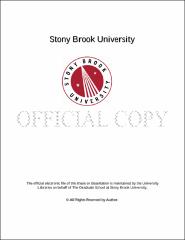| dc.identifier.uri | http://hdl.handle.net/11401/76428 | |
| dc.description.sponsorship | This work is sponsored by the Stony Brook University Graduate School in compliance with the requirements for completion of degree. | en_US |
| dc.format | Monograph | |
| dc.format.medium | Electronic Resource | en_US |
| dc.language.iso | en_US | |
| dc.publisher | The Graduate School, Stony Brook University: Stony Brook, NY. | |
| dc.type | Dissertation | |
| dcterms.abstract | In this thesis, we experimentally examine the evolution of partially wetting drop-lets in square microchannels, and the dynamic self-assembly and coalescence of droplets in a slit microchamber. In confined small-scale flows, variations and irregularities of the flow geometry introduce high degree of complexities for predicting and modeling the droplet interactions with each other and with walls during the multiphase transport. Con-struction of robust microgeometries along with precise control of the fluid interfaces using microfluidic techniques are used in conjunction with high-speed imaging to study the temporal evolution of two-phase flows. Immiscible two-phase flows mainly show two types of interactions: (1) the liquid-liquid interface can interact with the solid walls and (2) the liquid-liquid interfaces can interact with each other. A variety of wetting transi-tions are observed when the liquid-liquid interfaces are confined by the solid walls. Some of the dynamic wetting transitions in two-phase immiscible flows include dewetting of the lubricating film, stick-slip motion of contact line and the possibility of the dewetting line to align with the flow direction. We show that natural wetting properties of the fluid pair can be a useful parameter to classify the dynamic wetting transitions as well as the interfacial morphologies in microchannels. The relevant parameters to control the dynam-ic wetting transitions of the two-phase flow are presented with phase diagrams. To study the interactions of liquid-liquid interfaces, we examine the dynamic self-assembly of droplets in a diverging/converging slit microchamber. Focusing on the limit of dilute emulsions, formation and stability of self-assembled structures of droplets in the micro-chamber is investigated. We demonstrate that hydrodynamic coupling and coalescence of droplets in a simple extensional geometry can be controlled by adjusting the injection ca-pillary number as well as the aspect ratio of the incoming droplet train. | |
| dcterms.available | 2017-09-20T16:50:15Z | |
| dcterms.contributor | COLOSQUI, CARLOS | en_US |
| dcterms.contributor | CUBAUD, THOMAS | en_US |
| dcterms.contributor | WALKER, HAROLD | en_US |
| dcterms.contributor | HWANG, DAVID | en_US |
| dcterms.contributor | GENTLEMAN, MOLLY. | en_US |
| dcterms.creator | Jose, Bibin Mathew | |
| dcterms.dateAccepted | 2017-09-20T16:50:15Z | |
| dcterms.dateSubmitted | 2017-09-20T16:50:15Z | |
| dcterms.description | Department of Mechanical Engineering. | en_US |
| dcterms.extent | 133 pg. | en_US |
| dcterms.format | Application/PDF | en_US |
| dcterms.format | Monograph | |
| dcterms.identifier | http://hdl.handle.net/11401/76428 | |
| dcterms.issued | 2015-05-01 | |
| dcterms.language | en_US | |
| dcterms.provenance | Made available in DSpace on 2017-09-20T16:50:15Z (GMT). No. of bitstreams: 1
Jose_grad.sunysb_0771E_12223.pdf: 12186012 bytes, checksum: 669aea3089bde2dca028b5bff21cfba4 (MD5)
Previous issue date: 2015 | en |
| dcterms.publisher | The Graduate School, Stony Brook University: Stony Brook, NY. | |
| dcterms.subject | assembly, coalescence, droplet, microfluidics, spreading, wetting | |
| dcterms.subject | Mechanical engineering | |
| dcterms.title | Dynamic Wetting, Self-assembly, and Coalescence of Droplets in Microchannels | |
| dcterms.type | Dissertation | |

